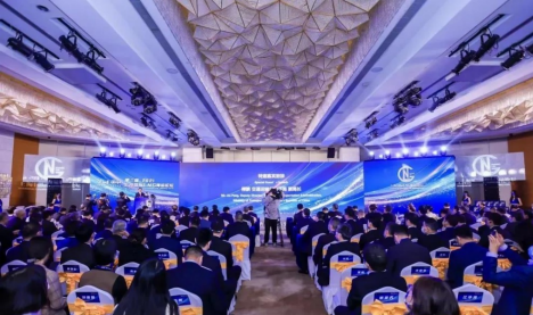Expert: China Becomes Major Engine of Global Gas Demand and LNG Trade Growth
- Time of issue:2022-02-07 14:54:56
- Views:
Expert: China Becomes Major Engine of Global Gas Demand and LNG Trade Growth
- Time of issue:2022-02-07 14:54
- Views:

Recently, at the 3rd Shanghai International LNG Shipping Forum, co-organized by China Ocean Shipping Group Co Ltd, China Merchants Group Co Ltd, Shokai Mitsui Co Ltd, Shanghai Oil & Gas Trading Center, China Financial Information Center and Shanghai Securities News, the participants and industry experts discussed the global LNG market, the current price situation and the outlook for the development of the LNG industry in the context of “double carbon”.
In the last year, natural gas has gone from being extremely oversupplied to being globally tight, with the TTF index in Europe remaining around $30/MMBtu and the LNG spot index in Asia more than tripling since January this year and remaining above $30/MMBtu as of early November.
According to Peter Fraser, Director of Gas, Coal, Power Markets at the International Energy Agency (IEA), the recovery of the global economy and additional activity has pushed up gas demand, as the frequency of extreme weather around the world; at the same time, the impact of upstream shutdowns and equipment maintenance due to the epidemic has reduced global gas supplies this year. In addition, due to the extremely cold weather last winter, a large amount of natural gas storage were consumed, resulting in existing storage volumes being lower than the average of previous years. On the one hand, the injection of gas storage will require an increase in existing gas demand, putting further pressure on spot LNG supply, while on the other hand, high prices in summer reduce the price differential between summer and winter, weakening the incentive to store gas in summer, causing storage injections in major gas consuming regions to be lower than the average of previous years, increasing the risk of price volatility for the upcoming heating season.
The IEA forecasts global gas demand to grow by 3.6% in 2021, and Peter Fraser says the rebound in global gas demand growth will not be sustained, mainly due to the current record high spot price of gas, which will dampen gas consumption growth to 1.5% in 2022. China will be the main driver of demand growth between 2020 and 2022, contributing 35% of incremental global gas demand and 80% of incremental LNG trade.
In 2020, China's natural gas consumption increased by 7.1% to 326.2 billion cubic meters, despite the severe epidemic. China's natural gas production was 192.6 billion cubic meters (including coalbed methane from local enterprises), an increase of 8.4% over the previous year and an increase of more than 10 billion cubic meters for the fourth consecutive year; natural gas imports were 140.8 billion cubic meters, an increase of 2.0%, including 67.13 million tons of LNG imports, an increase of 11.5%.
With the “double carbon” target, China will accelerate the transition from fossil-based energy to renewable energy, and the proportion of coal and other fossil energy consumption will gradually decrease, while oil and natural gas will still play a greater role in the process of achieving the “double carbon” target, Zhang Chunjun said, deputy general manager of the Shanghai Oil and Gas Trading Center.
The global natural gas market is not a unified market and has distinct regional characteristics, with three major markets – North America, Europe and Asia - still dominated by regional prices. China is currently the world's top oil and gas importer, importing about 73% of its oil and 43% of its natural gas consumption. As a major global oil and gas consumer market, we currently lack a matching trading market system and pricing center to objectively and truly reflect the supply and demand relationship in our energy market, and it is urgent to build an internationally influential oil and gas trading and pricing center, further improve market transparency, and build an oil and gas price system that reflects the supply and demand situation in the Asian market, Zhang Chunjun said.
Natural gas is a high-quality, clean and high-efficiency energy source. Expanding the scale of natural gas utilization and improving the level of natural gas utilization are of great significance to the development of energy transformation and the promotion of energy conservation and emission reduction. From January to August 2021, China's apparent consumption reached 240.6 billion, up 16.8% year-on-year. From January to September, China produced about 151.8 billion cubic meters of natural gas, up 10.4% year-on-year, and imported 89.85 million tons, up 22.2% year-on-year, including 58.48 million tons of LNG imports, up 22.7%.
Zhang Chunjun introduced that as an important force in building an international oil and gas trading and pricing center, the Shanghai Oil and Gas Trading Center is vigorously promoting on-line trading of oil and gas products. The main trading mode of the trading center platform contains lists, bidding, presale, bidding and group purchase, etc. The main trading products contain natural gas, oil products, facility capacity and information services, etc. The trading center has more than 3,000 members, covering domestic and foreign enterprises in oil and gas, finance and other fields. In the year 2020, the trade center's bilateral natural gas trading volume reached 81,148 million cubic meters, maintaining its position as the largest natural gas spot trading center in the Asia-Pacific region.
Focusing on regional LNG trade issues, Zhao Long, a researcher at the Shanghai Institute of International Studies, discussed the changes in Russia's LNG export policy and the development of Sino-Russian cooperation. Zhao said that the global zero-carbon race is not only a conceptual and strategic competition, but also a competition in technology and power. As a major fossil energy producer, Russia is anxious about the declining market demand for oil products in the face of carbon neutrality targets, and along with the decline in the political attributes of hydrocarbon products, there is also anxiety about power. Russia will use natural gas products to consolidate its power and position in the world energy landscape.
According to Zhao, the direction of Russia's energy policy adjustment is mainly in two aspects. First, Russia will seize the last dividend period of oil to speed up the exploitation and realization, and second, expand LNG production capacity to seize the global energy market. Russia in its first LNG strategy document proposes to increase LNG production from 80 million to 140 million tons in 2035, and to reach the goal of 26-33% of total global exports of natural gas and 20% of the global LNG market by 2035, by consolidating its energy influence in the European market and laying out new growth points in the Asia-Pacific market.
“LNG is definitely a core in Sino-Russian Arctic cooperation,” said Zhao, adding that Russia accounts for 25 percent of the world's natural gas reserves in the natural gas sector, while 95 percent of Russia's natural gas reserves are in the Arctic. Although the LNG industry in the Arctic is the most rapidly developing in Russia, it also faces climate, internal competition, and geopolitical pressures, which have had an impact on many Sino-Russian cooperation projects in the Arctic. “The cooperation between Russian and Chinese LNG projects should be considered in the overall layout of China's energy diversification imports. In addition to LNG, we can set up more 1+N models in hydrogen, wind and nuclear energy, and there may be more potential for the growth of Russian-Chinese cooperation in the Arctic in terms of these truly clean energy sources.” Zhao said.
The forum gathered nearly 20 academicians and experts in the industry and more than 200 industry elites, focusing on four themes: LNG trade, LNG shipping, new energy and new technology, and LNG industry chain supply chain synergy development, discussing the opportunities and challenges facing the LNG trade and shipping industry under the “double carbon” target.
Source: Shanghai Oil & Gas Trading Center
Relevant Information
Zhengzhou Anran I&C Technology Co.,Ltd.
Tel: 0086-371-68629564
E-mail: global.sales@zzanran.com
Address: The National University Science Park, No.11, Changchun Road, High&New Technology Development District, Zhengzhou
Copyright Zhengzhou Anran I&C Technology Co., Ltd.




 0086-371-68629564
0086-371-68629564

 Message
Message 




